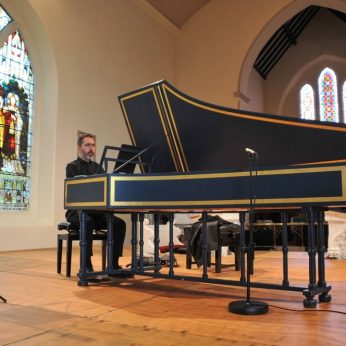Composer: Johann Sebastian Bach (b. 1685 - d. 1750)
Performance date: 28/06/2023
Venue: St. Brendan’s Church
Composition Year: 1738
Duration: 00:14:26
Recording Engineer: Gar Duffy, RTÉ
Instrumentation: S-solo, 2vn, va, vc, lu, hpd
Instrumentation Category:Baroque Ensemble
Artists:
Ensemble Diderot (Johannes Pramsohler, Roldán Bernabé [violins], Alexandre Baldo [viola], Gulrim Choï [cello], François Leyrit [bass], Jadran Duncumb [lute], Philippe Grisvard [harpsichord]) -
[Baroque Ensemble]

Harpsichord Concerto in D major BWV 1054 [c.1738]
1. Allegro
2. Adagio e piano sempre
3. Allegro
Bach was fond of recycling his material; along with his contemporary Handel he was a truly “green” composer. His seven concertos for harpsichord are all transcriptions of earlier works. They appear in a manuscript in his own hand completed around 1738. He probably produced them for the Collegium Musicum, the long-established orchestra mainly comprising students, which played in Zimmermann’s Coffeehouse each Friday in winter and in the coffee-garden outdoors on Wednesdays in the summer. It was the precursor to the famous Leipzig Gewandhaus Orchestra. Telemann had been its director in the early 1700s when he was in Leipzig, and Bach took charge on his appointment as Director of Music at St. Thomas Church in 1723. He enhanced its popularity and often played the solo parts in concerto performances. This concerto began life as his Violin Concerto in E major, BWV 1042, probably written during his previous appointment in Cöthen [1717-1723]. Bach brought the key down a tone and reworked the original quite extensively, not only to turn the solo part into music for a harpsichord but also in altering the orchestral material.
The music sets off with three brusque staccato chords followed by a lively theme with the harpsichord joining in straight away. The opening movement is ternary, that is in three parts with the opening section being repeated after a central contrasting sequence “A – B – A”. The bubbling first part with its chunky orchestral writing and flowing harpsichord gives way to a fresh, equally lively central episode, reaching a full stop before bringing back the opening music for a vigorous restatement. Adapting a slow movement for violin, with its long, arching phrases, to the percussive machinery of the harpsichord is not an easy task, but Bach as usual finds remarkably imaginative ways of creating a fine, continuous line for the soloist, while the strings provide a meditative accompaniment to a series of enchanting harpsichord variations on the principal melody. This charming reverie is broken by the explosive opening of the finale. It is the style of a French passepied en rondeau. The passepied was a rapid three-in-a-bar French dance and it is presented in rondo form: the main theme returning after contrasting episodes, four in all. Bach provides a wealth of imaginative idea in these sections, bringing this splendid Concerto to a lively conclusion.
Ian Fox
Copyright © 2025 West Cork Music. All rights reserved.
Designed and developed by Matrix Internet